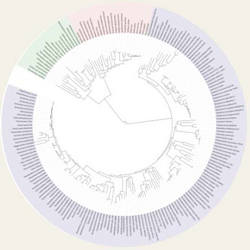The World That Darwin Made
A Modern Biology continued

The modern “tree of life” exhibits well Darwin’s sense of evolution. I. Letunic and P. Bork, "Interactive Tree of Life (iTOL)," Bioinformatics 23(1) (2007): 127-28.
The “tree of life” was a fruitful metaphor for the relations among living beings. Darwin provided a new explanation for it. The physical structures of life fall into relatively few templates: vertebrates are only the best known example, bones making up a backbone, ribs, head, articulated arms and legs, hands and feet, and a tail. Darwin’s theory led to an evolutionary taxonomy: he explained Linnaean taxonomic structure as the result of descent from a common ancestor, not as expressions of an ideal type. In the 1960s, with the work of Linus Pauling (1901-1994), the focus moved from whole organisms to their underlying molecular basis: in a classic study, the “molecular evolution” of hemoglobin was traced throughout the living world, in bacteria, fungi, algae, plants, as well as throughout the animal kingdom—the amount of difference between molecular structures correlating with the distance of divergence on the tree of life. At this level, Darwin’s theory affirmed both the unity of life and its diversity in its continuing elaboration.
The chief scientific difficulty with Darwin’s theory was the lack of a well understood theory of genetics. But by the early twentieth century, the genetics of Gregor Mendel (1822-1884) had been reaffirmed, and linked first to cells, then to chromosomes in the work of Thomas Hunt Morgan (1866-1945), and then to the molecules of DNA, by James Watson (b. 1928) and Francis Crick (1916-2004). As they stated in their classic 1953 Nature paper, “It has not escaped our attention that the specific pairing that we have postulated immediately suggests a possible copying mechanism for the genetic material.” (Nature 171, 4356 [25 April 1953]: 737–738, p. 737). In the twentieth century new disciplines of population genetics and evolutionary biology worked out the implications of Mendel’s genetics in natural populations. By 1942, Julian Huxley (1887-1975), Thomas Huxley’s grandson, could call the successes of Darwinism the “modern Darwinian synthesis”: it provided coherent explanations across a wide variety of disciplines—genetics, paleontology, botany, others—through the work of Sewall Wright (1889-1988), J. B. S. Haldane (1892-1964) , R. A. Fisher (1890-1962), Ernst Mayr (1904-2005), Theodosius Dobzhansky (1900-1975), and George Gaylord Simpson (1902-1984).
Last Reviewed: May 7, 2014


